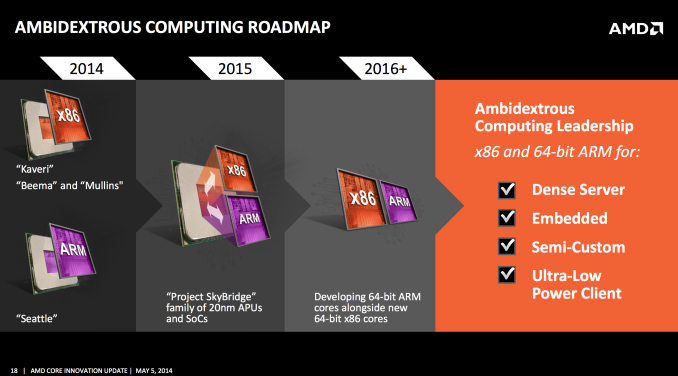AMD is also working on a new 64-bit x86 Core
by Anand Lal Shimpi on May 5, 2014 1:16 PM EST
Jim Keller joined Mark Papermaster on stage at AMD's Core Innovation Update press conference and added a few more details to AMD's K12 announcement. Keller stressed AMD's expertise in building high frequency cores, as well as marrying the strengths of AMD's big cores with those of its low power cores. The resulting K12 core is a 64-bit ARM design, but Jim Keller also revealed that his team is working on a corresponding 64-bit x86 core.
The x86 counterpart doesn't have a publicly known name at this point, but it is a new design built from the ground up.










112 Comments
View All Comments
Gizmosis350k - Wednesday, May 21, 2014 - link
Moore's law no longer applies to CPU processorstestbug00 - Monday, May 5, 2014 - link
Eh, it is entirely possible. Since Sandy, Intel has been reaching for the highest reaching fruits to try to get improvement, they have got very little.No reason why AMD could not get its own version of Conroe... Which, was based off of parts of PentiumM and P4 (and some other stuff, ofc)
Unless Intel is willing to make a new architecture, ground up, there is not much performance gains to be seen from its Big cores. Now, power efficiency improvements, that is a whole different story :)
gruffi - Tuesday, May 6, 2014 - link
AMD outperforms Intel's low power Atom cores with their low power Cat cores. High-end cores aren't everything. 99.9% of the market don't need processors like i7-4770K. And I don't need to mention iGPUs. So, in 2 of 3 fields AMD isn't on par. They are ahead of Intel in terms of performance. Some people really should take a look beyond Intel's propaganda machine.Gizmosis350k - Wednesday, May 21, 2014 - link
Exactly, Intel isn't god, they just paid him off to sit in his throne for a day and he decided to humour themArnulf - Monday, May 5, 2014 - link
Working on similar projects like these might not mean double the required number of people - there might be synergy between the projects, at least with regards to some building blocks. besides, they are hedging their position.At some point ARM will hit desktop in larger numbers, allowing for even cheaper computers. A complete quad core 2+ GHz ARM system should be doable at lower cost than the price of a quad core Intel CPU, using less power (and, admittedly, offering lower performance ... but how much performance is really needed for majority of workloads?).
gostan - Monday, May 5, 2014 - link
you do know that synergy is a marketing buzzword right? right? right? right?mrdude - Monday, May 5, 2014 - link
No, he's right. The RISC vs. CISC wars have ended a long time ago, and vast portions of modern CPU architectures are actually incredibly similar. For example, AMD can utilize the same components like the IMC, loop buffers, and on-die GPU across what are "different" architectures.And we've seen this before with AMD and Intel both. AMD used the branch predictor from Jaguar/Bobcat in their Piledriver cores because it was more efficient, and we all remember how Intel transitioned and borrowed from their Pentium-M.
The worry of splitting resources is still there though, given AMD's significantly smaller R&D size. But that 'synergy' buzzword isn't just a buzzword. I'm far more worried about execution in a timely manner, as AMD has dropped the ball repeatedly there in the past few years.
testbug00 - Monday, May 5, 2014 - link
in the past few years (since BD release) the only large issue AMD had was with Kaveri launch.AMD is getting better and better at execution.
Not enough to stop worry, but, enough to where it is "AMD could screw up this execution" instead of "Well, we will see this coming in 2017 if we are lucky"
mrdude - Tuesday, May 6, 2014 - link
The A8-7600, imo the pick of the litter, has been pushed back to the tail end of the year. But remember that Kaveri was meant to launch last year but was replaced by Richland, which was just Trinity with a clock speed bump.Then there's Kabini/Temash, which started out in life as Wichita/Krishna, were then redesigned and ported to TSMC's 28nm, and then back to 28nm GloFo, and finally replaced by Beema and Mullins.
AMD has definitely had execution problems, and it's been this way for as long as I can remember. This isn't to say that other semicos don't, but AMD is already in a precarious position with end customers and OEMs alike skeptical regarding execution and timeline. Unfortunately, it's a reputation that's well deserved.
Gizmosis350k - Wednesday, May 21, 2014 - link
Exactly, but everyone feels that sitting back and trash talking the underdog gets them paid or something